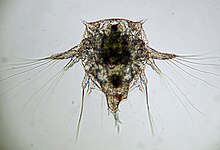This entry is a week overdue. Last Sunday we had a '
supermoon' around here. Basically all that
means for me is an exceptionally low tide, and boy was it ever. As it turned out, I had to go look for more
Crepidula egg masses to get more larvae, so off I went on an early Sunday morning.
 |
Just about at the lowest point of the tide.
If you look back through my archives, you can see this jetty at various tidal heights --
but trust me, this is very low for around here. |
It was a beautiful morning to be out. I saw several
black-crowned night herons, one of my favorite shore birds. Lots of crabs, several egg masses of various gastropods, and very few people. (It was quite early on a Sunday.) But the morning was particularly notable because I saw all three species of
Crepidula that exist in this part of the world.
First, here are some
C. plana living inside a whelk shell. Tucked way back in the shell was a large hermit crab, who declined to be photographed.
 |
| C. plana in a whelk shell. These are all pretty big organisms, and almost certainly all females. |
These guys are called "plana" because they are flat. There's several species of flat, white slipper snails around the world, but the ones we have here are
C. plana. Once you take them off their substrate, they look just like
C. fornicata, except a little paler and a lot more delicate. Their larvae are identical to
C. fornicata, though a little smaller.
Second, here's the recurring star of the blog,
C. fornicata. This stack is noteworthy because you can see some of this year's new recruits on it. They're 1-2 mm in length and have just settled and metamorphosed on this stack. Not all of the adult
C. fornicata had recruits yet, which isn't unexpected given the
slow spring start this year.
 |
| C. fornicata stack, with a couple of the tiny recruits indicated with blue arrows. |
But I've saved the best for last:
C. convexa, or the convex slipper snail. These guys look like tiny
C. fornicata unless you know what you're looking for. They are smaller overall, so big
C. convexa females are the same size as pretty small
C. fornicata males. This actually was how I first identified them at my site, in my first graduate school summer: I found individuals that should have been males, based on size, but were obviously females brooding large embryos. I worked through some keys for the species, which included taking animals out of their shells to look at the shape differences in their interiors. To me, this is the most obvious morphological difference between them.
 |
| C. convexa and C. fornicata shells, animals removed. Not to scale. The blue arrows indicate the 'shelf' of the shell. When the snail is alive, its digestive gland and gonad are tucked behind that shelf, and the foots sits on the other side of it. It's all that remains of a more standard-looking coild snail shell. The difference is that C. convexa, on the left, has a shelf edge that looks something like a Nike swoosh, while C. fornicata (right) has a wavy shelf edge. Photo of C. fornicata from Wikipedia. |
Anyway, eventually I got to the point where I can see the differences in the live animals without even removing them from their substrate, and now the two look very different to me -- but it took a lot of practice to get here.
One of the cool things about
C. convexa is that they do not have swimming veliger larvae. Instead, they are direct developers: the mothers brood their embryos all the way through development, and they hatch as tiny crawl-away juvenile snails. They therefore have much less dispersal than either
C. fornicata or
C. plana, which can travel on ocean currents as larvae. I've spent a fair amount of time researching what the consequences of these dispersal differences might be.
One of those consequences is definitely that
C. convexa is very patchily distributed within an area, and is usually hard to find. I knew they were at my study site, but it's probably been two years since I found more than one or two at a time. Last Sunday, though, the tide was low enough to expose their hiding places.
 |
C. convexa living on top of a mud snail shell that is currently occupied by a hermit crab.
There's two C. convexa in that blue circle: a large female on the bottom and a smaller male on top.
You may just have to trust me on that, though.
There's also another C. convexa on the lower left edge of the shell, just to the left of the crab's legs. |
I was thrilled to find these guys here in large numbers. I think they're my favorite
Crepidula species, mostly because of those adorable crawl-away juveniles.
And when I got back to the lab, I did in fact find the
C. fornicata larvae that I had gone out to get, so now more experiments are happening.






.JPG)
.JPG)
.JPG)






























